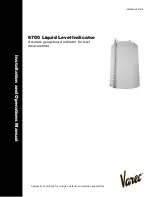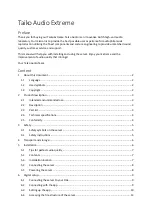
Operator's Manual
WP700Zi-OM-E-RevA
492
m_to_r MSNR-to-RSNR
Ratio
Definition
Provides a media signal-to-noise residual to signal-to-noise ratio for single-frequency, sector-
based waveforms.
Description
The m_to_r ratio provides a quick measurement to compare the media noise with the residual
noise. If this ratio is greater than 1.00, the signal is residual, or electronics noise dominated.
The measurement is calculated by:
m_to_r =
m
/
r
Parameter
Settings
After specifying the location of the “Head Signal” and the optional “Read Gate,” selection of
m_to_r is automatic after you touch the
Noise Analysis
button. Touch the
Setup for Single
Frequency
button to initialize the measurement.
PRML Channel Emulation
This introduction to PRML and its concepts explains the role of the PRML channel chip
components
. It describes how the Channel Emulation feature of
the Disk Drive Analyzer works together with them using equalization, clock and gain recovery, maximum
likelihood detection, sequenced amplitude margin, and encoding and error detection.
Why PRML?
For the remarkable gains in disk drive capacity to continue, media and head performance improvements are no
longer enough. Faced with equally impressive advances in semiconductor technology, disk drive engineers have
been working to create a new read-channel architecture that will allow capacity to grow unimpeded.
The answer lies in the construction of the disk itself. The disk’s magnetic poles, with two orientations possible
along the track, store the bits as "0" and "1". When the drive reads, the head detects the transition from one pole
to another, as bit "0" to bit "1", for instance. If such transitions are "far away," or low-density, the drive will see
isolated pulses. But to increase density, the pulses can be made shorter and placed closer together or kept wide
but overlapping. While the first of these alternatives, represented by Peak-Detect systems, has reached its limits,
the second, Partial-Response Maximum Likelihood (PRML), has allowed the industry to go on boosting capacity.
The overlapping pulses of partial-response systems allow much greater density. PRML systems have more
samples per pw50, which is defined as the width of an isolated pulse at 50% of its amplitude. And the more
complex, or higher-order, the PRML system, the greater the density that can be obtained. Comparing typical
values achieved by available PRML systems with Peak-Detect we find:
Density of Samples per pw50
Peak Detect
1
PRML
PR4 1.65
Содержание DDA 7 Zi series
Страница 1: ...Operator s Manual WavePro SDA and DDA 7 Zi Series Oscilloscopes ...
Страница 2: ... L R R H HUD RU D D ...
Страница 41: ...Operator s Manual WP700Zi OM E RevA 40 The detachable WavePro Zi front panel ...
Страница 376: ...WavePro 7Zi 375 WP700Zi OM E RevA Absolute Offset Relative ...
Страница 439: ...Operator s Manual WP700Zi OM E RevA 438 ...
Страница 440: ...WavePro 7Zi 439 WP700Zi OM E RevA ...
Страница 544: ...Thank you for purchasing a WavePro SDA or DDA 7 Zi Oscilloscope ...
















































